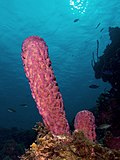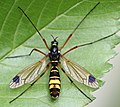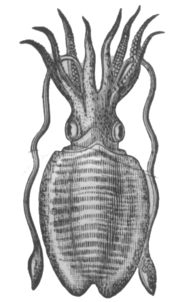 | Ctenophora (/təˈnɒfərə/; sg.: ctenophore /ˈtɛnəfɔːr, ˈtiːnə-/; from Ancient Greek κτείς (kteis) 'comb', and φέρω (pherō) 'to carry') comprise a phylum... 109 KB (12,173 words) - 22:25, 27 April 2024 |
Ctenophora apicata is a species of large crane fly in the family Tipulidae. "Ctenophora apicata Report". Integrated Taxonomic Information System. Retrieved... 1 KB (58 words) - 06:53, 26 September 2019 |
 | Commons has media related to Ctenophora elegans. Wikispecies has information related to Ctenophora (Ctenophora). Ctenophora elegans at insectoid.info v t e... 1 KB (40 words) - 16:32, 30 January 2024 |
animal clade consisting of the Porifera and ParaHoxozoa as sister of the Ctenophora. An alternative phylogeny is given by the Porifera-sister hypothesis in... 4 KB (112 words) - 22:35, 21 January 2024 |
Ctenophora nubecula is a species of large crane fly in the family Tipulidae. "Ctenophora nubecula Report". Integrated Taxonomic Information System. Retrieved... 1 KB (58 words) - 06:54, 26 September 2019 |
 | historical context. In the early 19th century, Georges Cuvier united Ctenophora and Cnidaria in the Radiata (Zoophytes). Thomas Cavalier-Smith, in 1983... 7 KB (591 words) - 23:49, 25 October 2023 |
Somatina ctenophora is a moth of the family Geometridae. It is found in Kenya, Namibia and South Africa. Wikimedia Commons has media related to Somatina... 1 KB (72 words) - 18:30, 31 December 2020 |
 | because the large differences between Porifera (sponges), Cnidaria plus Ctenophora (comb jellies), Placozoa and Bilateria (all the more complex animals)... 82 KB (8,938 words) - 18:20, 14 April 2024 |
Collocyte (section Collocytes in Ctenophora) and celebrated examples of collocytes are those of the Ctenophora (comb jellies). The Ctenophora use their colloblasts or collocytes in hunting and gathering... 8 KB (1,083 words) - 14:27, 29 June 2023 |
Megachile ctenophora is a species of bee in the family Megachilidae. It was described by Holmberg in 1886. "Megachile". BioLib. 2014. Retrieved 10 October... 622 bytes (28 words) - 03:35, 23 June 2018 |
organisms which develop from such a blastula, and include Cnidaria and Ctenophora, formerly grouped together in the phylum Coelenterata, but later understanding... 2 KB (192 words) - 15:29, 23 February 2024 |
 | e. the bilaterians. The less-advanced taxa (i.e. Placozoa, Porifera, Ctenophora and Cnidaria) do not show consolidation of their tissues into organs.... 21 KB (2,016 words) - 13:09, 3 February 2024 |
 | are not so primitive, but may instead be secondarily simplified. The Ctenophora and the Cnidaria, which includes sea anemones, corals, and jellyfish,... 41 KB (4,736 words) - 08:12, 11 April 2024 |
 | sister group of Porifera (sponges). The basal eumetazoan clades are the Ctenophora and the ParaHoxozoa. Placozoa is now also seen as a eumetazoan in the... 13 KB (1,211 words) - 00:37, 11 April 2024 |
 | Ctenophora Genus Abundance Notes Images Ctenorhabdotus 5 specimens This ctenophore had rows of cilia to help it swim in the water column. It had around... 72 KB (1,446 words) - 18:35, 16 April 2024 |
 | but including only two species of sponge, suggested that comb jellies (ctenophora) are the most basal lineage of the Metazoa included in the sample. If... 126 KB (13,138 words) - 05:08, 28 April 2024 |












